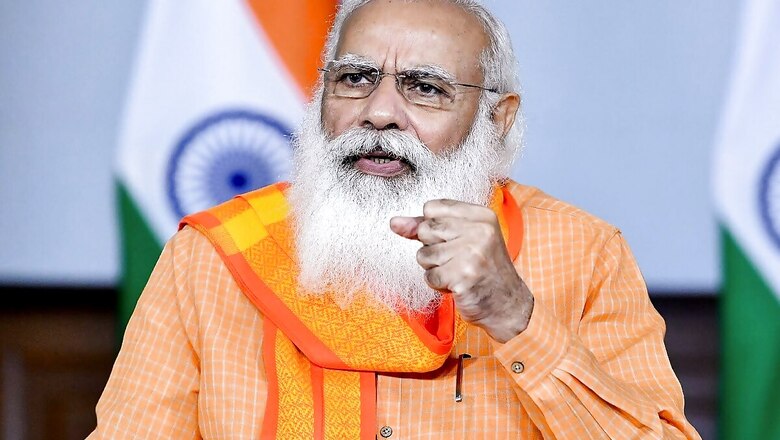
views
The Narendra Modi government has completed its seventh year in office amid the second wave of the COVID-19 pandemic. This second wave has completely exposed our healthcare system, which comes under the domain of the state governments. India is battling to save lives as well as livelihoods.
Now, we are witnessing a fall in active COVID cases and the focus of the government is on saving livelihoods. There are concerns that our growth has turned negative in the last fiscal, which has a consequential impact on various macroeconomic factors like unemployment rate, per capita income, tax collection etc. To put a perspective to the GDP decline discussion, it is worthwhile to highlight that the COVID crisis has impacted the global economy. However, during the 2008 global financial crisis, India remained largely unaffected.
According to the Reserve Bank of India (RBI), COVID-19 has impacted the global output. At an estimated -3.3 per cent, this is the steepest contraction since the Great Depression of 1929, according to some reports. However, as per the World Bank data, our GDP growth came down from 7.6 per cent in 2007 to 3.08 per cent in 2008 and if decline in growth is the only criteria, then it can be concluded that the Manmohan Singh government failed miserably because 2008 sub-prime crisis had very little impact on India.
Consultancy firm McKinsey published a survey report in April 2021, which shows that the economic outlook is upbeat in India and the respondents are optimistic about the future prospects. Though Sensex is not the barometer of the economy, but this optimism is visible in the stock market as well where indices have touched new high. Profit-GDP ratio of listed companies has hit a four-year high in FY 2020-21. Corporates with good credit rating are able to borrow from the market at a rate lower than the bank lending rate which has contributed to a decline in credit growth, but this has been made an issue by the opposition without verifying the underlying facts.
Unemployment is another important issue which is often raised in the media. First of all, the reports which are cited as source to highlight the unemployment rate lack the comparative data and therefore it becomes difficult to draw a meaningful conclusion about the performance of the UPA and the NDA governments. As a matter of fact, the COVID crisis has raised the unemployment rate across the globe and India can’t be an exception to it when we had a full lockdown during the first wave and phase-wise lockdowns imposed by state governments during the second wave. For comparison, unemployment rate in Italy could be in double digits this year.
There is no denial that job loss has happened but it is also a fact that adequate support has been provided to the operating entities. The government has promised to bear the provident fund contribution for two years of those who have either lost their jobs due to COVID or new employees on the payrolls of the company. In the Indian context, micro, small and medium-scale enterprises (MSMEs) were impacted to a large extent; for them, the government provided emergency credit line to the eligible borrowers. The economic impact of the COVID crisis is in the nature of cash-flow crisis for most MSMEs and they needed a temporary support in the form of extended credit which is currently being served by the Emergency Credit Line Guarantee Scheme (ECLGS).
It is unfortunate that our opposition is not shying away from misrepresenting the facts. They never dared to call COVID-19 a Chinese virus (the country from where it originated) but naming a virus variant as the “Indian variant” gives them comfort as well as the illusion that they will succeed in defaming Narendra Modi through these theatrics. Same goes with highlighting Bangladesh per capita GDP as higher than ours. This discussion came up in the media when the IMF published World Economic Outlook report in which a temporary decline in per capita GDP was expected. However, the entire discussion by the opposition dishonestly hides the fact that the same report of the IMF suggests that India will overtake our tiny neighbour in the next year itself. Apart from this, the Purchasing Power Parity (PPP) is a good indicator if someone is doing per capita analysis and we are far ahead of our neighbours on this parameter. It is not logical to compare Indian economy with Bangladesh and if mere per capita GDP is the criteria for economic supremacy, then Sri Lanka and Bhutan stand better-off compared to many larger nations.
Economic growth is the collective responsibility of the Centre and state governments because enabling factors like land, and law and order are state subjects while labour relations come under concurrent list of the Constitution. State governments are responsible for creating a better atmosphere which gives assurance to the investors before they commit their money. It would be better if opposition comes up with some data which shows that states ruled by them have fared better in terms of economic growth and social welfare.
Read all the Latest News, Breaking News and Coronavirus News here.
















Comments
0 comment